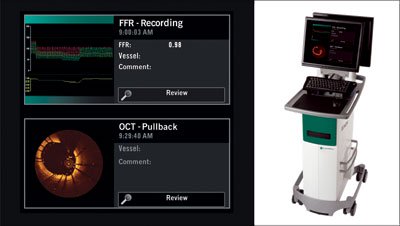PCI Optimization Through Combined FFR, OCT Platform
by Joel A. Garcia, MD
 |
|
| Joel A. Garcia |
The method of PCI optimization through the use of fractional flow reserve and optical coherence tomography is a rapidly growing concept among coronary interventionalists.
The recently FDA-approved ILUMIEN PCI Optimization System (St. Jude Medical) is the first integrated diagnostic technology that combines OCT and wireless FFR. The dual functionality offers physicians advanced physiological and anatomical insight to improve the diagnosis and treatment of CAD.
The combined platform allows physicians to first identify and measure characteristics of blood flow through blockages in coronary arteries, and then assess stent placement during the procedure. This new capability potentially provides a solution to the issue of over-stenting (via an initial physiologic evaluation) while also aiming at improving stent performance/effectiveness post-deployment (via an anatomical evaluation).
Angiography and IVUS
Angiograms have long been considered the gold standard when it comes to identifying lesions that require the placement of a stent. However, its imaging limitations have become evident as more advanced and accurate imaging technology has come to market; angiograms alone are no longer sufficient to determine which lesions need treatment. IVUS uses ultrasound technology to image plaque volume within artery walls. This reading can show the degree of stenosis of the artery, helping to identify culprit lesion(s), but does not provide physiologic insight on disruptions to the blood flow within the arteries. IVUS can also assist in PCI guidance.
FFR and OCT
The idea of FFR is to assess the flow of blood through arteries in the presence of stenosis and in relation to normal blood flow in a normal segment. FFR informs treatment options by providing a physiological perspective of a patient’s artery and irrigated myocardium so physicians can determine whether a narrowing is causing flow disturbance.
|
Images: St. Jude Medical |
The ability of an interventional cardiologist to repair arteries and restore proper blood flow is directly related to the quality of the tools available. The advanced diagnostics of FFR and improved imaging of OCT (10 times more resolution than IVUS) can produce more information than would otherwise be ascertained by either an angiogram or IVUS.
Evaluating Stenosis with FFR
FFR is an index determining the functional severity of a given stenosis in the coronary artery. FFR specifically identifies which coronary narrowings are responsible for significantly obstructing the flow of blood to a patients’ heart muscle likely causing ischemia and is used by interventional cardiologists to direct treatment.
Current data show that physiological assessment using FFR before placement of coronary stents helps physicians better optimize clinical outcomes by determining the specific lesion or lesions responsible for a patient’s ischemia. In January 2009, the results of the Fractional Flow Reserve vs. Angiography in Multivessel Evaluation (FAME) study, which enrolled 1,005 patients with multivessel CAD and compared outcomes for patients whose treatment was guided by FFR with those whose treatment was guided by angiography only, were announced. The 12-month results, published in the Jan. 15, 2009 issue of The New England Journal of Medicine, demonstrated that instances of MACE, including death, MI or repeat revascularization, were reduced by 28% for patients whose treatment was guided by FFR rather than by standard angiography alone. After 2 years, patients who received FFR-guided treatment continued to experience improved outcomes over time, including a 34% risk reduction in MACE.
OCT for CAD
OCT is an imaging technology platform that aids physicians in the diagnosis and treatment of CAD. OCT uses near-infrared light to create images that help visualize and measure important vessel characteristics otherwise not visible or difficult to assess with older intracoronary imaging technologies. OCT is especially important for the assessment of stent placement. The high-resolution images show how effectively the stent has expanded within the artery and whether it is positioned correctly against the artery wall, ultimately resulting in treatment optimization.
Although there is limited data proving the benefit of OCT over other vascular imaging technologies, the resulting image improvements are very clear: OCT yields far greater visualization and clarity, not unlike a consumer’s leap from regular television to high-definition television.
A Marriage of Technologies
Integrating FFR and OCT technologies in the ILUMIEN system offers physicians the tools to identify, diagnose and prescribe treatment.
Over-stenting has recently gained national attention after the Appropriateness of Percutaneous Coronary Intervention study was published in the July 6, 2011 issue of the Journal of the American Medicine Association. The study found that unnecessary stent placements were on the rise, a trend potentially countered by the ILUMIEN system, which can help offer visual and diagnostic support useful in medical decision-making via the anatomical and more importantly the physiologic evaluation of CAD.
In addition, the ILUMIEN system has 10 times better resolution and is 20 times faster than IVUS, resulting in accurate, automated and standardized measurements, and provides physicians with the ability to differentiate and classify plaque, and to identify significant lesion(s). The ILUMIEN system can help guide stent placement and, once deployed, allows physicians to determine and evaluate the stent-to-vessel interaction.
By integrating FFR and OCT technologies, physicians are equipped with innovative technology that gives them the information to more accurately diagnose and prescribe therapy for patients in the cath lab.
References:
Chan PS. JAMA. 2011;306:53-61.
Tonino PAL. N Engl J Med. 2009;360:213-224.
Joel A. Garcia, MD, FACP, FACC, FSCAI, FCCP, is the director of the Denver Health Medical Center Catheterization Laboratory and Interventional Services, and is an assistant professor at the University of Colorado Denver.
Disclosure: Dr. Garcia is a consultant for St. Jude Medical but does not receive any financial gain; all honoraria is paid to Denver Health Medical Center.

